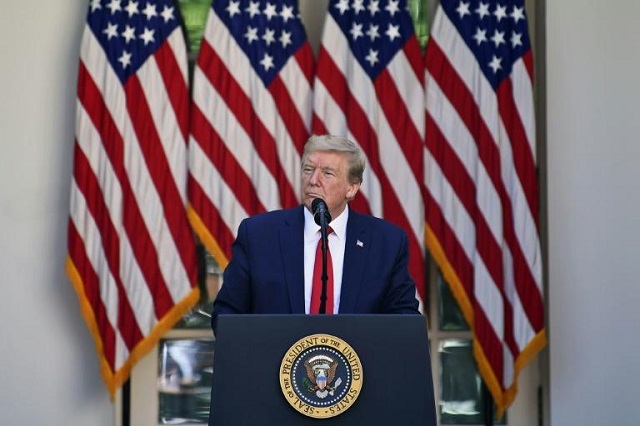
Washington, United States | AFP | The United States on Friday recorded its steepest job losses in history over the coronavirus pandemic as Europe, faced with rising deaths, moved to keep its borders shut for another month.
Hopes have been rising that the worst of the global catastrophe, which has killed more than 270,000 people, has passed, and the United States on Friday approved a new at-home saliva test to speed up diagnosis for COVID-19.
But after weeks in which half of humanity was restricted from carrying on normal life, the effects have been painfully visible, with the global economy suffering its most acute downturn in nearly a century.
In the United States, 20.5 million jobs were wiped out in April — the most ever reported — with unemployment rising to 14.7 percent, the highest since the Great Depression.
The world’s largest economy has suffered the deadliest coronavirus outbreak, with more than 77,000 fatalities and nearly 1.3 million cases.
Mindful of elections in November, President Donald Trump has nonetheless vowed to reopen the country, and a growing number of state governors have already let business resume with precautions.
Trump played down the unemployment numbers, saying they were expected, as the White House pointed to substantial gains Friday on global stock markets as proof that better times were ahead.
“We’re going to have a phenomenal year next year,” Trump told reporters. “I think it’s going to come back blazing.”
His optimism came even as the virus spread within the White House, with the press secretary of Vice President Mike Pence testing positive.
Neighboring Canada also shed three million jobs, bringing its unemployment rate up to 13.1 percent, two days after the European Union forecast a massive recession in the bloc.
– Still ‘fragile’ –
Two of America’s most prominent companies, Google and Facebook, are taking no chances and said they would let employees telework through the end of the year.
But a number of governments are moving to ease restrictions. Germany, Europe’s biggest economy, took decisive early action that stemmed the virus and Chancellor Angela Merkel plans an almost complete return to normal within the month.
Italy, where deaths on Friday passed 30,000, plans to allow worshippers to return to mass, while Denmark said Friday that cinemas, museums and zoos would unshutter on June 8.
In Britain, which has suffered the world’s highest death toll after the United States, Prime Minister Boris Johnson is expected to offer a roadmap out of lockdown on Sunday.
But the European Commission recommended that the 27-nation bloc keep banning non-essential entry of visitors until June 15, an extension of one month.
“The situation remains fragile both in Europe and in the world,” it said in a statement.
Ylva Johansson, the EU commissioner for home affairs, said the first priority will be removing temporary border controls to restore free movement within the bloc — a key principle of the union.
The virus that has infected 3.9 million people worldwide overshadowed one of the most important dates on the European calendar — the anniversary of the end of World War II on the continent.
Parades and commemorations to mark 75 years since Nazi Germany’s surrender were canceled or scaled down, and the thoughts of many national leaders were on fighting the new global challenge.
“For us Germans, ‘never again’ means ‘never again alone,'” said President Frank-Walter Steinmeier, who laid a wreath in Berlin along with Merkel — the two standing apart in line with social distancing guidelines.
“We want more, not less, cooperation in the world — also in the fight against the pandemic,” Steinmeier said.
Far from bringing the world together, the crisis has triggered a war of words between China, where the virus first appeared in the metropolis of Wuhan, and the United States, where Trump has battled criticism over his handling of an epidemic which he boasted of having under control in January.
The Trump administration has brought into the mainstream a theory that the virus came from a Wuhan laboratory, despite the World Health Organization and the top US epidemiologist saying there is no evidence.
China rejects the charge, and America’s allies are not convinced.
According to German news weekly Der Spiegel, citing a leaked internal memo, Germany’s defense ministry and spy agency see Trump’s claim as a “calculated attempt to distract” from his own administration’s failings.
– No unity at UN –
The feud spread Friday to the UN Security Council, where the United States, stunning other members, prevented a vote on a resolution that called for a ceasefire in various conflicts around the world.
The resolution, led by France and Tunisia, called for a cessation of hostilities in conflict zones and a 90-day “humanitarian pause” to allow governments to better address the pandemic among those suffering most.
A State Department official told AFP that China had “repeatedly blocked compromises that would have allowed the Council to move forward.”
Diplomats said the United States was concerned about language in the resolution on the role of the World Health Organization, which has been at the forefront of confronting COVID-19.
Trump has vowed to freeze the more than $400 million in annual US funding for the UN body, saying it did not act quickly enough when the mysterious respiratory disease emerged in Wuhan and blindly took the word of China.
The US State Department on Friday also accused China and Russia of sharply escalating disinformation online about the virus, including promoting conspiracy theories that it was cooked up by US scientists.
– Home tests by saliva –
With the US death toll and infections still climbing, regulators on Friday offered a way to ramp up testing — a diagnostic kit that uses saliva.
The Food and Drug Administration gave emergency approval to the home-collection option, which is significantly easier than the most common test which involves swabbing inside a patient’s nose.
The new kit, developed by Rutgers Clinical Genomics Laboratory, is a rare test that does not require a trip to a doctor or other testing site.
Public health workers warn that a complete return to normal is impossible until the development of a vaccine, which could take months if not more.
Trump, however, again offered rosy predictions as he said a vaccine was not a prerequisite to end the pandemic.
“At some point it will probably go away by itself,” he told reporters, while adding: “If we had a vaccine, that would be very helpful.”
 The Independent Uganda: You get the Truth we Pay the Price
The Independent Uganda: You get the Truth we Pay the Price


